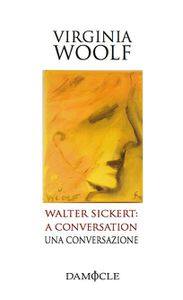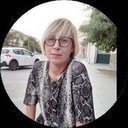
Virginia Woolf and Walter Sickert
#literature #painting
Published in 1934 by the Hogarth Press, the essay connects Virginia Woolf to Walter Richard Sickert, whom she, in her diary, calls "my Sickert" (see annotations of Tuesday April 17, 1934) complaining that, with the painter she loves, critics "They are contemptuous" (Friday 2 November 1934).
Reflecting on Mario Praz's statement that: "Woolf's technique could approach that of pointillism", we think that it is composed of "a plurality of isolated moments, randomly put together by the imagination" (again Mario Praz) therefore precisely a sort of literary pointillism, of writing impressionism . Sickert broke away from Whistlerian origins - and therefore Pre-Raphaelite - to approach Degas, who taught him not only to portray from life, but also to paint on the basis of memories, photographs, drawings and introduced him to the school of French impressionism. He then became the main exponent of the Camden Town Group, of English post-impressionist matrix.
Woolf describes an imaginary conversation that took place on a December evening. The text opens with a piece of skill on chromatism, on insects that are all eyes, indeed, one, with the color they see, to the point of absorbing it. One immediately notices how much the Woolfian language draws on poetry, drinking from it and, while keeping the rationality intact, it turns into lyricism.
"When I first went into Sickert's show, said one of the diners, I became completely and solely an insect - all eye. I flew from color to color, from red to blue, from yellow to green. Colors went spirally through my body lighting a flare as if a rocket fell through the night and lit up greens and browns, grass and trees, and there in the grass a white bird.
Sickert is a biographer, Woolf manages to extrapolate entire lives, plots, narratives from his portraits.
“Yes, Sickert is a great biographer, said one of them; when he paints a portrait I read a life. "[…] When he sits a man or woman down in front of him he sees the whole of the life that has been lived to make that face."
If the novelist shows us what he describes, that is, in a certain sense, paints and brushes, Sickert "writes" a story. We have a sort of chiasmus, a cross between the pairs of Woolf - Sickert and writing - painting.
For Woolf, more than a portraitist and biographer, Sickert is a novelist, like Dickens or Balzac. His characters draw on reality, he loves to describe the middle class, the workers in their squalor, in their suffering, in the faces shaped by fatigue and disillusionment, in the garments deformed by use, in the worn and cheap furniture. We hear these characters move and talk, we build plots around them, we listen to the conversations, the noises that surround them, that come from the street, from the open windows.
While a realist, Sickert is not a pessimist. It is as if in his paintings there is a hint of a parallel condition, of which the characters are an unconscious part, a reality of greater joy and fullness of life. Moreover, although of humble origins, his figures are never degraded. They are well-fed men and women who enjoy the pleasures of life, the possession of simple objects, good food. There is always intimacy between the characters and their rooms, their interiors. Every object, a chest of drawers, a hat, a glass, a bed, is an expression of the owner. Human nature is never far from Sickert's painting, in the background of his paintings there is always a human being, a seller, a passer-by.
Sickert narrates without running the risk of falling into sentimentality, as happens to novelists. He tells with a brushstroke of green or red, with a gesture of the hand, dry and wrapped in silence. And, however, he is still a true poet, you can see him above all in the paintings that portray Venice, the circus, the music hall, the markets. Beyond the concrete, fleshy subject, there is always a sky, a cloud, a red-gold light that we can even hear "dripping" from the brush into the image. In this way he makes us aware of beauty, of hidden poetry, even if he is not a visionary or a rhapsode, he is not a Blake or a Shelley. His painting "is made not of air and star-dust but of oil and earth"
Painting and writing have a lot in common, Woolf describes the torment of the novelist who tries to make us "see" what he has in mind. The following passage can be considered a real poetic manifesto.
“The novelist is always saying to himself how can I bring the sun on to my page? How can I show the sun and the moon rising? And he must often think that to describe a scene is the worst way to show it. It must be done with one word, or with one word in skilful contrast with another. […] They both speak at once, striking two notes to make one chord, stimulating the eye of the mind and of the body "
The essay continues with a roundup of great writers - from Pope, to Keats, to Tennyson - whose pictorial but also musical properties Woolf analyses, the unconscious lexical choice that serves to nourish the reader's eye and ear. Woolf believes that there is no contemporary writer capable of writing life as Sickert knows how to paint it.
“Words are an impure medium; better far to have been borne into the silent Kingdom of paint "
Throughout the essay she refers to that border beyond which there is only silence, there is the desperation of the writer unable to express what he sees, the music in his head, the picture in his mind. It is what Praz calls "the oppression of the enormous burden of the unexpressed".
“We try to describe it and we cannot; and then it vanishes, and having seen it and lost it, exhaustion and depression overcome us; we recognize the limitations which Nature has put upon us. " page 77)
Finally, in the essay, there is no lack of a thrust against criticism, of which Woolf felt she was a victim, as can also be seen from the reading of her diary; criticism which, in fact, is not always able to grasp the pictorial and musical nuances of writing, but remains relegated and limited to the printed page.
Better to be silent, says Woolf, better to go into the "silent land", the silent land that stands in the place of - or perhaps beyond - the word, where all art is combined, where poetry, painting and music merge, where drops of color, written words and melodies become one, where the meaning disappears and gives way to preconscious understanding, to pure emotion that satisfies and gratifies.
- Comments (0)
- Recommended
- Milestones
Here are your recommended items...
Here are your milestones...



